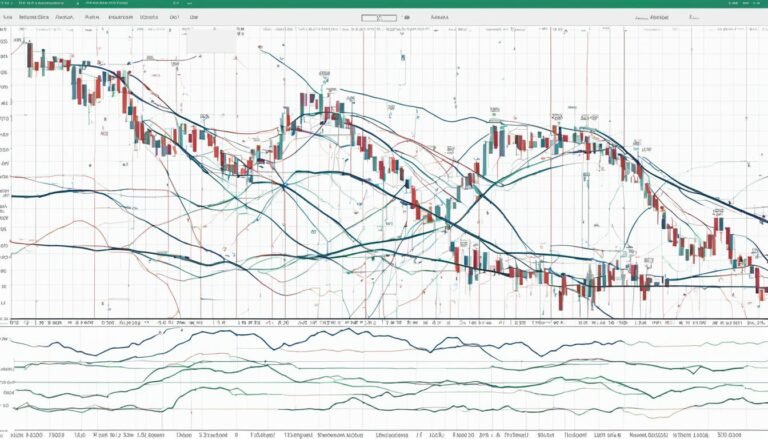Asset Pricing Models: Key Theories Explained
The field of asset pricing models is integral to determining the intrinsic value of securities in financial markets. In this article, we will delve into essential theories behind asset pricing models, including the capital asset pricing model (CAPM), arbitrage pricing theory, and equity valuation models. We will also explore key concepts such as the market risk premium, risk-free rate, and the relationship between risk and return in asset pricing.
Understanding asset pricing models is crucial for investors, financial analysts, and researchers who aim to make informed decisions based on the underlying theories regarding the value of various financial instruments. Whether you are engaged in fundamental analysis or pursuing a career in quantitative finance, a solid understanding of different asset pricing models is essential.
Key Takeaways:
- Asset pricing models play a critical role in determining the intrinsic value of securities in financial markets.
- The capital asset pricing model (CAPM), arbitrage pricing theory, and equity valuation models are key theories in asset pricing.
- The market risk premium and risk-free rate are important components in asset pricing models.
- Fundamental analysis and quantitative finance heavily rely on asset pricing models to make informed investment decisions.
- Understanding the relationship between risk and return is fundamental in asset pricing theory.
What is the Capital Asset Pricing Model (CAPM)?
The Capital Asset Pricing Model (CAPM) is a widely used finance model that provides insights into the relationship between risk and expected return. This model establishes a linear relationship between the required return on an investment and its risk level. CAPM specifically focuses on systematic risk, which is the risk related to market-wide factors that affect the entire industry or market segment.
The CAPM formula takes into account various factors to determine the expected return on an investment. These factors include an asset’s beta, the risk-free rate, and the equity risk premium. Beta measures the sensitivity of an asset’s returns to market movements. The risk-free rate represents the hypothetical return on a risk-free investment such as government bonds. The equity risk premium quantifies the additional compensation investors require for holding a risky asset compared to a risk-free investment.
“The CAPM model provides a valuable framework for pricing securities and estimating expected returns. It allows investors to understand the relationship between risk and return, aiding in the decision-making process.”
CAPM is widely utilized in finance for various purposes. It helps investors understand whether an investment provides sufficient returns given the associated risks. Moreover, it assists in pricing risky securities and determining the expected returns for different assets. By using CAPM, investors can assess the riskiness of an investment and compare it with the potential returns it offers.
Key Factors in the CAPM Model
| Factor | Description |
|---|---|
| Beta | A measure of an asset’s sensitivity to market movements. It indicates how much an asset’s returns are expected to change for a given change in the market. |
| Risk-Free Rate | The hypothetical return on a risk-free investment. It serves as a benchmark for evaluating the expected returns on risky investments. |
| Equity Risk Premium | The additional return investors demand for holding a risky asset compared to a risk-free investment. It compensates for the higher risk associated with the asset. |
The CAPM model simplifies the complex relationship between risk and return by providing a straightforward formula. However, it is important to note that CAPM has its limitations, including making certain assumptions that may not hold true in real-world scenarios. These assumptions include the efficient market hypothesis and the linear relationship between risk and return. Despite its limitations, CAPM remains a valuable tool in finance for understanding and estimating the expected returns on investments.
Limitations of the CAPM
The Capital Asset Pricing Model (CAPM) is a widely used finance formula that provides valuable insights into the relationship between risk and return. However, it is important to recognize the limitations inherent in this model.
Unrealistic Assumptions
The CAPM is built upon a set of assumptions that may not accurately reflect real-world conditions. One such assumption is the efficient market hypothesis, which suggests that all relevant information is reflected in an asset’s price. In reality, markets can be influenced by irrational behavior and incomplete information.
“While the CAPM is a useful tool, it is important to recognize that it relies on several assumptions that may not hold true in practice.”
Linear Interpretation of Risk vs. Return
The CAPM assumes a linear relationship between risk and return, suggesting that investors are solely concerned with maximizing returns while minimizing risk. However, this simplistic interpretation may not capture the complexity of investors’ risk preferences and subjective evaluations of potential rewards.
Ignorance of Diversification Benefits
The CAPM overlooks the benefits of diversification in portfolio management. It assumes that investors are solely interested in the risk and return characteristics of individual assets, disregarding the potential risk reduction achieved through a well-diversified portfolio. In reality, diversification can help mitigate risk and improve overall portfolio performance.
Market Efficiency
The CAPM assumes that markets are perfectly efficient, meaning that prices instantaneously and accurately reflect all available information. However, markets can be influenced by various factors, including sentiment, market manipulation, and informational asymmetry, which may result in inefficient pricing.
Despite these limitations, the CAPM remains valuable as a tool for comparing investment alternatives, as it provides a simplified framework for assessing potential risks and rewards. By understanding these limitations, investors can make more informed decisions and incorporate complementary models and strategies into their investment processes.
| Limitations of the CAPM | Explanation |
|---|---|
| Unrealistic Assumptions | The CAPM relies on assumptions such as efficient markets, which may not hold true in practice. |
| Linear Interpretation of Risk vs. Return | The CAPM assumes a linear relationship between risk and return, overlooking the complexities of investor risk preferences. |
| Ignorance of Diversification Benefits | The CAPM does not consider the risk reduction achieved through diversification. |
| Market Efficiency | The CAPM assumes perfectly efficient markets, which may not reflect reality. |
Arbitrage Pricing Theory (APT)
The Arbitrage Pricing Theory (APT) is another asset pricing model that seeks to explain the relationship between risk and return. APT suggests that the price of an asset is determined by various risk factors or factors that affect asset returns.
Unlike the Capital Asset Pricing Model (CAPM), which uses a single factor (systematic risk) to predict asset prices, APT takes a broader approach by considering multiple risk factors. These factors can include macroeconomic variables, industry-specific variables, and company-specific variables.
APT provides a framework for pricing assets based on these risk factors, allowing investors to assess the expected return of an investment considering different variables that impact asset returns.
“APT provides a more comprehensive and flexible approach to pricing assets compared to CAPM. By considering multiple risk factors, APT accounts for a broader range of influences on asset returns, resulting in a more accurate valuation.”
One of the key advantages of APT is its ability to capture the complexity of real-world financial markets, where multiple factors influence asset prices. By incorporating various risk factors, APT recognizes that the pricing of assets is not solely influenced by market-wide systematic risk, but also by other factors specific to different industries and companies.
Furthermore, APT enables investors to analyze the impact of different risk factors on asset returns and make well-informed investment decisions. By understanding the specific factors driving returns, investors can strategically allocate their portfolios to optimize risk-adjusted returns.
Overall, the Arbitrage Pricing Theory (APT) provides a robust alternative to the Capital Asset Pricing Model (CAPM) by considering a broader range of risk factors. By incorporating multiple factors that affect asset returns, APT offers a more nuanced and comprehensive approach to pricing assets, allowing investors to make informed investment decisions.
Equity Valuation Models
Equity valuation models serve as valuable tools in determining the value of stocks. These models utilize fundamental analysis to estimate the intrinsic value of a stock based on various factors such as cash flows, earnings, and book value. By evaluating these key metrics, investors can make informed decisions about the attractiveness of a stock and whether it is overvalued or undervalued in the market.
Two commonly used equity valuation models are the discounted cash flow (DCF) model and the residual income model.
Discounted Cash Flow Model
The discounted cash flow model is a widely used valuation technique that estimates the present value of a company’s future cash flows. It calculates the intrinsic value of a stock by discounting the projected cash flows at a suitable discount rate, generally referred to as the company’s cost of capital. The DCF model takes into account the time value of money, recognizing that a dollar received in the future is worth less than a dollar received today.
Residual Income Model
The residual income model, also known as the abnormal earnings model, calculates the intrinsic value of a stock by comparing a company’s net income with the equity charge, which represents the minimum return required by investors to compensate them for their equity investment. The residual income model views a company’s traditional earnings as the cost of equity capital and any residual or excess income above that as additional value created for shareholders.
In addition to these models, certain ratios are commonly used in equity valuation, such as the price-to-earnings ratio (P/E ratio) and the price-to-book ratio (P/B ratio). The P/E ratio compares a company’s stock price to its earnings per share and provides insight into how the market values the company’s earnings. The P/B ratio compares a company’s stock price to its book value per share and indicates how much investors are willing to pay for each dollar of net assets.
Understanding these equity valuation models and ratios is essential for investors looking to make informed investment decisions based on thorough analysis and a comprehensive understanding of a company’s value.
| Equity Valuation Models | Key Features |
|---|---|
| Discounted Cash Flow Model (DCF) | – Estimates present value of future cash flows – Considers time value of money – Determines intrinsic value based on discount rate |
| Residual Income Model | – Measures excess income above cost of equity capital – Considers net income and equity charge – Calculates additional value created for shareholders |
| Price-to-Earnings Ratio (P/E ratio) | – Compares stock price to earnings per share – Reflects market’s valuation of a company’s earnings |
| Price-to-Book Ratio (P/B ratio) | – Compares stock price to book value per share – Indicates value placed on each dollar of net assets |
The Relationship Between Risk and Return
Asset pricing models are based on the fundamental principle that investors expect to be compensated for taking on risk. The relationship between risk and return is a key concept in finance, and asset pricing models aim to quantify this relationship. Investors require a risk premium, which is the excess return they demand for taking on additional risk. The level of risk tolerance varies among investors and can impact their investment decision-making.
When determining the appropriate level of risk and return, investors must consider their individual risk tolerance. Risk tolerance refers to an investor’s willingness and ability to accept the potential loss of their invested capital. It is influenced by various factors, including financial goals, time horizon, and personal circumstances. Investors with a higher risk tolerance may be more willing to take on riskier investments that offer the potential for higher returns.
“Risk and return are inherently linked in the financial markets. Investors who are willing to take on more risk have the potential to earn higher returns, while those who prefer less risk are likely to experience lower returns.”
Risk assessment is also crucial when it comes to evaluating the performance of an investment. Risk-adjusted return is a measure that accounts for the level of risk taken to achieve a certain return. It helps investors compare different investments and determine which ones offer the best risk-return tradeoff. By considering the risk-adjusted return, investors can make more informed decisions and allocate their capital effectively.
The Risk Premium and Its Importance
The risk premium is an essential concept in asset pricing. It is the additional return that investors expect to receive for taking on risk above the risk-free rate. The risk-free rate represents the return on a risk-free asset, such as government bonds. The risk premium compensates investors for the uncertainty and volatility associated with investing in riskier assets.
| Risk-Free Rate | Market Return | Risk Premium |
|---|---|---|
| 2% | 8% | 6% |
In the table above, the risk-free rate is 2% and the market return is 8%. Therefore, the risk premium is calculated as 6% (8% – 2%). This indicates that investors demand a 6% excess return for taking on the additional risk of investing in the market.
Understanding the relationship between risk and return is crucial for investors in making informed decisions. By analyzing asset pricing models and considering risk-adjusted returns, investors can navigate the complex nature of financial markets and strive to achieve their investment goals.
The Role of the Market Risk Premium and Risk-Free Rate
In asset pricing models, two crucial components that determine the required rate of return and pricing of risky securities are the market risk premium and the risk-free rate. The market risk premium represents the additional return expected from the market in comparison to the risk-free rate. On the other hand, the risk-free rate serves as a baseline for measuring the expected return on risk-free assets.
The market risk premium reflects the compensation investors demand for bearing the uncertainty associated with investing in the market. It considers factors such as economic conditions, market sentiments, and the overall performance of the market. A higher market risk premium implies that investors expect greater returns in exchange for taking on more risk. Conversely, a lower market risk premium indicates a lower compensation for assuming market risk.
The risk-free rate, also known as the risk-free interest rate, represents the return an investor can expect to earn from an investment with no risk of default. It is typically derived from the yield of government bonds or other low-risk fixed-income instruments. In asset pricing models, the risk-free rate serves as a benchmark against which the expected return on risky assets is compared. If an investment is expected to generate a return lower than the risk-free rate, it may be considered undesirable.
By incorporating the market risk premium and the risk-free rate into asset pricing models, investors can assess the attractiveness of different investment opportunities. These factors help determine whether the expected return on a particular asset adequately compensates for the associated risks. Furthermore, the market risk premium and the risk-free rate enable investors to compare the returns offered by different securities and make informed investment decisions.
Understanding the Equity Risk Premium
The equity risk premium is a key concept related to the market risk premium. It represents the additional return that investors require for investing in equity (stocks) compared to risk-free assets. The equity risk premium compensates investors for the higher level of risk associated with equity investments, such as fluctuations in stock prices and the possibility of losing capital.
“The equity risk premium reflects the compensation investors demand to bear the volatility and uncertainty inherent in equity investments.”
The equity risk premium is influenced by various factors, including market conditions, corporate performance, and investor sentiment. A higher equity risk premium indicates that investors require higher returns for investing in stocks, while a lower equity risk premium suggests that investors are more willing to accept lower returns for the perceived risk associated with equity investments.
Understanding the market risk premium, the risk-free rate, and the equity risk premium is crucial for investors seeking to evaluate investment opportunities, assess expected returns, and make informed decisions. These concepts allow investors to navigate the complexities of asset pricing and align their investment strategies with their risk preferences and return objectives.
Market Risk Premium and Risk-Free Rate Example
To illustrate the role of the market risk premium and the risk-free rate, consider the following example:
| Investment | Expected Return | Market Risk Premium |
|---|---|---|
| Stock A | 7% | 5% |
| Stock B | 9% | 7% |
| Treasury Bond | 3% | N/A |
In this example, Stock A offers an expected return of 7% with a market risk premium of 5%. This means that investors anticipate earning a return 5% higher than the risk-free rate by investing in Stock A. On the other hand, Stock B offers a higher expected return of 9% with a higher market risk premium of 7%. This indicates that Stock B is riskier than Stock A, and investors demand a higher compensation for taking on that extra risk.
Comparing the returns of both stocks to the risk-free rate, which is represented by the 3% return of the Treasury Bond, investors can assess whether these investments adequately compensate for the level of risk involved. Stock A offers a return 4% higher than the risk-free rate, while Stock B offers a return 6% higher. These comparisons help investors make informed decisions and allocate their capital to investments that align with their risk-return preferences.
The Role of Asset Pricing Models in Quantitative Finance
In the field of quantitative finance, asset pricing models serve as fundamental tools for analyzing financial markets and making informed investment decisions. These models utilize mathematical and statistical methods to quantify the relationship between risk and return, providing valuable insights for researchers and practitioners. They play a crucial role in various aspects of quantitative finance, including quantitative modeling, portfolio optimization, and risk management.
Quantitative finance involves the application of mathematical models and statistical techniques to analyze financial data and develop investment strategies. By utilizing asset pricing models, practitioners can effectively quantify the impact of risk factors on asset returns and estimate the expected returns for different investment options.
Asset pricing models also contribute to portfolio optimization by helping investors construct portfolios that maximize returns while minimizing risks. These models provide insights into the trade-off between risk and return, allowing investors to make strategic decisions based on their risk tolerance and investment objectives.
Risk management is another crucial area where asset pricing models prove invaluable. By understanding the relationship between risk and return, practitioners can identify and mitigate potential risks in their investment portfolios. These models enable investors to make well-informed decisions by considering the risk profile of different assets and optimizing their exposure accordingly.
Example of Quantitative Modeling using Asset Pricing Models:
One common application of asset pricing models in quantitative finance is the development of quantitative models that predict stock prices based on various risk factors. For example, a quantitative model may incorporate factors like market volatility, interest rates, and company-specific financial indicators to estimate the fair value of a stock.
“Quantitative modeling allows us to incorporate complex variables into our analysis, enabling more accurate predictions of stock prices. By leveraging asset pricing models, we can harness the power of quantitative techniques to enhance our investment strategies and make informed decisions.”
To illustrate the practical application of asset pricing models, consider the following hypothetical example:
| Stock | Beta | Market Risk Premium | Risk-Free Rate | Expected Return |
|---|---|---|---|---|
| Company A | 1.2 | 7% | 3% | 10.4% |
| Company B | 0.8 | 7% | 3% | 8.6% |
In this example, asset pricing models are used to calculate the expected returns for Company A and Company B based on their beta, market risk premium, and risk-free rate. The expected returns are then used as input to make investment decisions, such as selecting the optimal portfolio allocation or comparing investment alternatives.
The role of asset pricing models in quantitative finance cannot be understated. These models provide a framework for understanding the relationship between risk and return and enable researchers and practitioners to make data-driven investment strategies. By incorporating asset pricing models into their analysis, finance professionals can gain valuable insights into the dynamics of financial markets and enhance their ability to navigate the complexities of quantitative finance.
The Importance of Asset Pricing Theory in Fundamental Analysis
Asset pricing theory plays a crucial role in fundamental analysis, which is the process of evaluating the intrinsic value of a stock. By analyzing financial statements, industry trends, and economic factors, fundamental analysts aim to determine the true worth of a stock and make informed investment decisions. Asset pricing theory provides the theoretical foundation for estimating the intrinsic value of a stock based on various factors such as cash flows, earnings, and market risk.
Fundamental analysts believe that the market may misprice stocks in the short term, but over the long term, stock prices tend to converge towards their intrinsic value. Asset pricing theory helps fundamental analysts uncover stocks that may be undervalued or overvalued by comparing their intrinsic value to their market price. This analysis provides valuable insights for investors looking to identify investment opportunities and make profitable trades.
One commonly used approach in fundamental analysis is the discounted cash flow (DCF) model, which estimates the present value of a stock’s future cash flows. By discounting the expected cash flows to their present value using an appropriate discount rate, analysts can assess whether a stock is undervalued or overvalued. This approach relies heavily on asset pricing theory to determine the discount rate, taking into account the risk associated with the investment.
Furthermore, asset pricing theory is crucial for investment analysis and stock valuation. By considering factors such as risk, return, interest rates, and expected cash flows, analysts can determine the fair value of a stock and make informed investment decisions. In conjunction with other valuation techniques, such as ratio analysis and industry comparisons, asset pricing theory provides a comprehensive framework for evaluating the value of a stock within the context of the broader financial market.
“Fundamental analysis is a discipline that requires a deep understanding of asset pricing theory. It goes beyond the surface-level market trends and provides investors with valuable insights into the underlying value of a stock.”
Example of Intrinsic Value Calculation Using Asset Pricing Theory
To illustrate the importance of asset pricing theory in fundamental analysis, consider the following example:
| Company | Earnings Per Share (EPS) | Growth Rate | Discount Rate | Intrinsic Value | Market Price | Under/Overvaluation |
|---|---|---|---|---|---|---|
| ABC Corp | $3.50 | 5% | 8% | $43.75 | $35.00 | Undervalued |
| XYZ Inc | $2.00 | 10% | 10% | $40.00 | $45.00 | Overvalued |
| DEF Co | $1.80 | 4% | 9% | $34.29 | $30.00 | Undervalued |
In this example, asset pricing theory is used to estimate the intrinsic value of three different stocks. By considering factors such as earnings per share, growth rate, and the appropriate discount rate, analysts calculate the intrinsic value for each stock. Comparing the intrinsic value to the market price reveals whether the stock is undervalued or overvalued. This analysis provides valuable insights for investors looking to potentially profit from market inefficiencies.
Asset pricing theory is an indispensable tool for fundamental analysis and stock valuation. By incorporating this theory into investment analysis, investors can make well-informed decisions based on the true value of stocks, identifying potential opportunities for profit.
Conclusion
Asset pricing models play a crucial role in the field of finance, enabling investors to determine the intrinsic value of securities and make informed investment decisions in financial markets. By understanding key theories such as the capital asset pricing model (CAPM), arbitrage pricing theory, and equity valuation models, investors can navigate the complexities of asset pricing and optimize their portfolio strategies.
The capital asset pricing model (CAPM) provides a framework for assessing the relationship between risk and return, allowing investors to evaluate the expected returns of assets based on factors like beta, the risk-free rate, and the equity risk premium. Arbitrage pricing theory expands on this by considering multiple risk factors that influence asset returns, such as macroeconomic, industry-specific, and company-specific variables.
Equity valuation models, on the other hand, utilize fundamental analysis to estimate the intrinsic value of stocks, taking into account factors such as cash flows, earnings, and ratios like the price-to-earnings ratio and price-to-book ratio. These models provide valuable insights into the true worth of a stock and aid investors in making sound investment decisions.
With a comprehensive understanding of asset pricing models and their key theories, investors can confidently navigate the dynamic landscape of financial markets, identify mispriced securities, and capitalize on investment opportunities that align with their risk appetite and financial goals. By leveraging these models, investors can optimize their returns and mitigate risks, ultimately achieving success in their investment endeavors.







